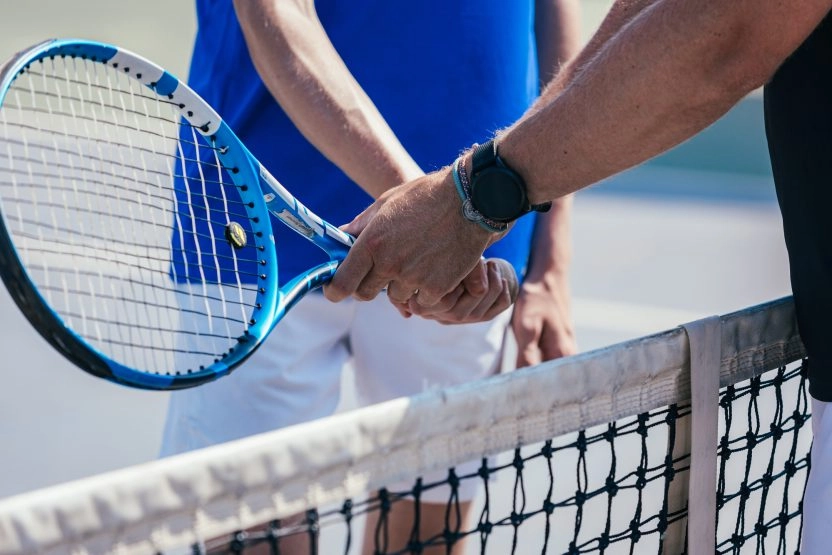1. Improved grip : It offers a better grip, allowing the player to hold the racket more firmly, which can prevent slipping when hitting.
Choosing the right handle size for your tennis racket is crucial for a comfortable grip and avoiding injury. An ill-fitting racket can affect your performance and lead to muscle pain, particularly in the wrist. Here are the essential tips for choosing the right handle for your hand and playing style. At the Mouratoglou Academy, we know that every detail counts when it comes to performance. Our experts help each player to identify the ideal equipment, including handle size, to ensure comfort and efficiency on the court. To take things a step further, our Tennis Clinics offer a unique opportunity to evaluate and adjust your equipment with the help of our professional coaches, to optimise your game and prevent injury.

How to determine the size of your grip
There’s a simple way to tell if a tennis racket is right for your hand. Holding the racket normally, close your hand around the grip. There should be enough space to place yourring finger between your fingers and the palm of your hand. If your ring finger touches the palm, the grip is too small. If there is a large gap, the grip is too big.
You can also measure the size of your grip using a ruler. Place the ruler between the centre of your palm and the tip of your ring finger. The dimension obtained will enable you to determine the correct grip size in inches.
What size grip should I choose?
Grips sizes vary according to racquet brand and model. For example, at Wilson or Head, you’ll find sizes ranging from L0 to L5. The choice depends on several factors:
- Juniors (under 11) generally use the L0 or L1 size.
- Women generally prefer L1 or L2 sizes.
- Men opt for L2 or L3, with exceptions up to L4 or L5 for larger hands.
If you are unsure, we recommend that you choose the smallest size, as it is always easier to add an overgrip to increase the size of the handle slightly.
What are L1, L2 and L3 in a tennis racket?
Sleeve sizes are often expressed using codes such as L1, L2 or L3, which correspond to grips sizes in Europe and the USA. Here’s a summary:
- L1 : Size for juniors and some women (equivalent to 4 1/8 inches in US size)
- L2 : Standard size for women and some men (4 1/4 inches in US size)
- L3 : Standard size for men (4 3/8 inches in US size)
Grips sizes and equivalents
European and American sizes are generally expressed slightly differently. Here’s a chart to help you choose the right grip size:
- L0 : 4 inches (Juniors)
- L1 : 4 1/8 inches
- L2 : 4 1/4 inches
- L3 : 4 3/8 inches
- L4 : 4 1/2 inches
- L5 : 4 5/8 inches
If you play with Wilson, Head or other major brands, this system is the same. Also take into account your playing style when choosing the grip size. For example, players who like to play with a lot of lift will prefer a thinner grip for better wrist flexibility.
What happens if my grip is the wrong size?

If it’s too big?
This can have a number of disadvantages:
- It will be more difficult to turn the racket quickly to adjust the grip, which can affect your performance.
- You risk wrist or elbow pain, particularly tennis elbow due to poor grip.
- A handle that’s too big also affects your balance and control of the racket, particularly for shots that require good mobility such as backhands and volleys.
If it’s too small?
This forces the player to grip the racket tighter, which can lead to muscle pain or arm strain. Players who use a smaller handle can also suffer from tennis elbow because of the overload exerted on the muscles and tendons.
Which grip should you choose according to your playing style?
- Powerful players : A slightly larger grip gives you better control on powerful shots.
- Players with a lot of lift : A smaller grip will give you more mobility to put spin on the ball, particularly on lifted shots.
Size can also influence racquet balance . A wider handle reduces its ability to switch quickly from one position to another, particularly on fast shots such as serves and volleys.
Why use an overgrip?
A tennis overgrip is an adhesive strip that is wrapped over the original grip of the handle. There are several advantages to using an overgrip:
These strips are easy to change, and many players replace them regularly to maintain optimum grip.








